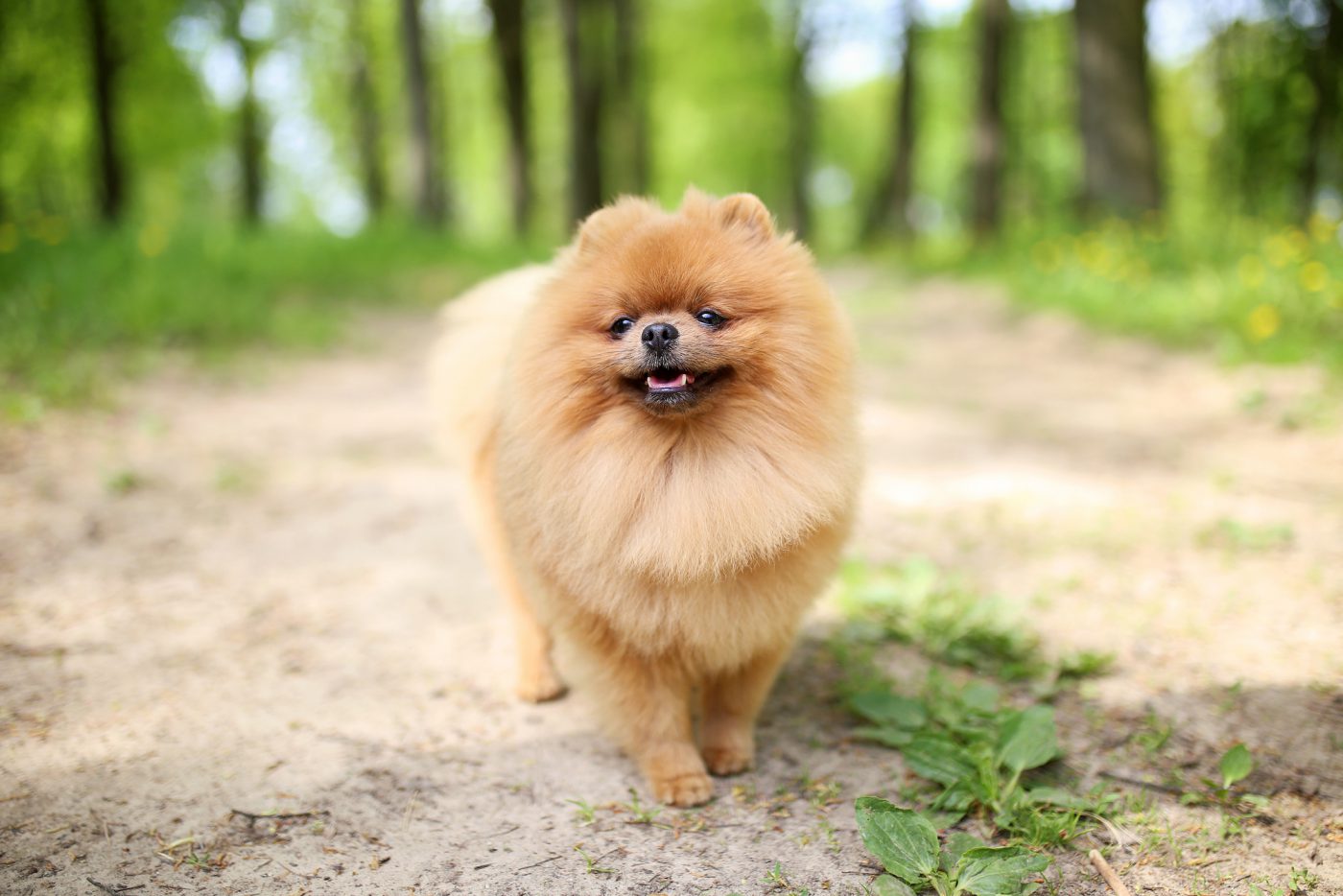Popular, affectionate, and spirited, Pomeranians are small, but—though one may be happy to spend some time perched on your lap—they are more than just lapdogs. This miniature pup was bred down from larger dogs like the German spitz—and while it’s the smallest of the spitz breeds and thus a good fit for apartment-dwellers, the Pom has plenty of energy and a boldness disproportionate to its physical size.
If you’re considering joining the ranks of those who have brought Poms into their homes, or want to be a better human to the one who’s sitting with you right now, read on.
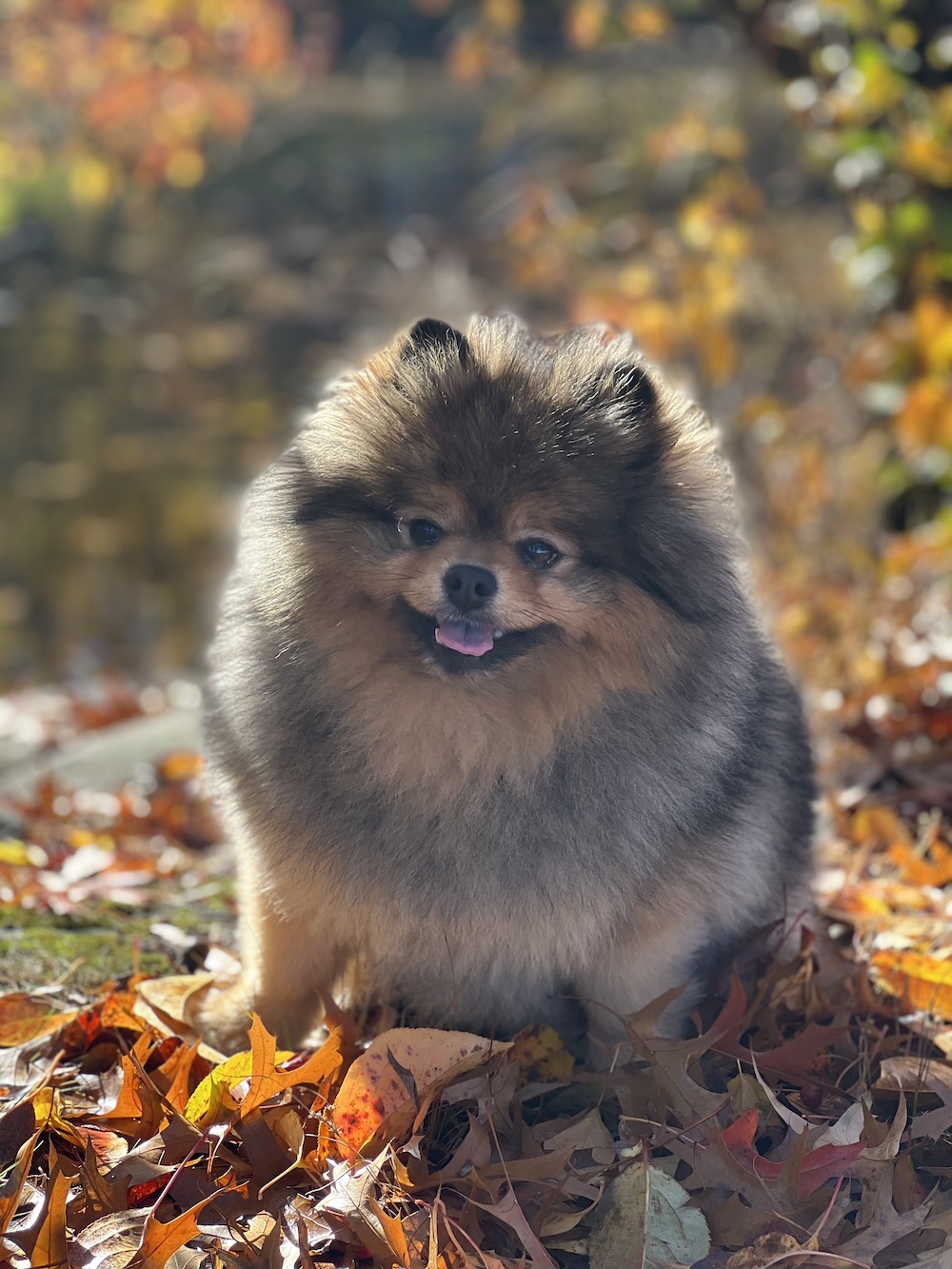
Pooh Bear
Basic Pomeranian facts
According to the American Kennel Club, the compact Pomeranian ranges from three to seven pounds, and a healthy Pom will typically live 12 to 16 years. The breed takes its name from Pomerania, a region in Europe that includes parts of Poland and Germany.
“Should I get a Pomeranian?”
That depends on your needs and the dog’s, but there is much to recommend the breed.
Pomeranians’ personalities have charmed the breed’s devotees for centuries. Says Leesa Molina, CEO of Southern California Pomeranian Rescue, “They’re like clowns—they make you happy. They can read your mind.”
“They want to be with you all the time,” Molina says. “They’ll follow you everywhere. They want to sleep right next to you.” So if you get a Pom, be ready to enjoy lots of time together—and know that you can’t go to work for eight hours and leave them by themselves. Poms can be a good fit for apartment dwellers, as they’re small dogs who can get enough exercise in a compact home with toys and chews, along with at least twice-daily walks outside.
You should never leave your Pom outside unattended. “They cannot be outdoor dogs,” says Molina. “They’re small, and birds of prey can pick them up. Coyotes can climb over. It’s like leaving a toddler out in the backyard as far as we’re concerned.”
Poms’ coats require frequent grooming, and you’ll have to pay extra attention to their dental care. Families with children should make sure that their kids treat their Pom with respect. This goes for any dog, but is extra important with such a tiny pup. While Poms tend to be social dogs who can get along with youngsters, they’re fragile—so children must be supervised, taught to respect their dogs, and never allowed to roughhouse with them.
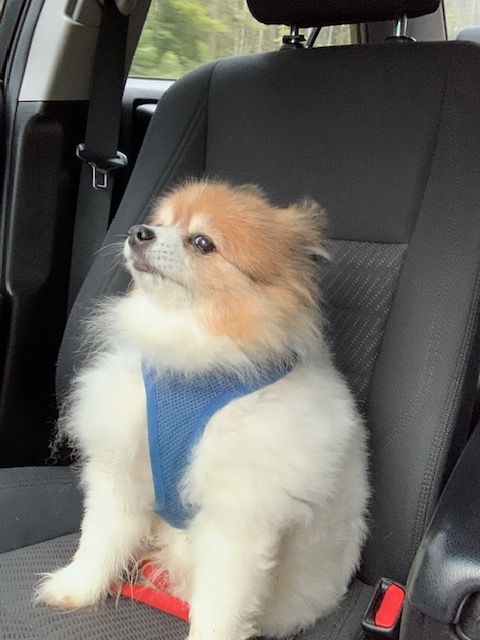
Maxwell
Pomeranian breed history
Queen Victoria of the United Kingdom is credited with popularizing the Pom, and breeding Pomeranians down from the size of larger spitzes, in the late 1800s. As time went on, the breed retained its regal reputation along with its goofy smile.
Two Pomeranians survived the crash of the Titanic. And, when it comes to the arts, Pomeranians seem to be disproportionately responsible for highbrow fare. Snoopy of Peanuts fame may be a beagle, Lassie a collie, and Slinky in Toy Story a dachshund—but, over the years, Pomeranians served as fluffy muses for the type of works one puts on a tux to enjoy. And yes, to be fair, Jenny Slate does voice a Pomeranian in The Secret Lives of Pets as well.
Still, Chopin’s “Waltz of the Little Dogs,” more famously known as the “Minute Waltz,” was reportedly inspired by his friend’s Pomeranian chasing its tail. Various sources say that Mozart dedicated an aria to his own Pomeranian, Pimperl. And Michelangelo had his Pom with him while he worked on the ceiling of the Sistine Chapel.
The arts cannot lay exclusive claim to Pomeranians—the sciences, too, may bear their mark. An oft-repeated story says that Isaac Newton’s own Pomeranian, Diamond, knocked over a candle and burned papers documenting some of his experiments. Newton allegedly forgave the pup, saying “little do you know the mischief you have done me.” Other histories give canine-free explanations for the burned papers, and some say Newton never owned a dog at all. But for the purposes of this history section, we’re going to repeat the story and rate it “plausible enough.”
One Pomeranian of whose existence we are quite certain is Boo. This Pom rose to fame as an early-ish social media celebrity and the subject of books and merchandise. Boo was marketed as “the world’s cutest dog.” While this is a subjective judgment that would be impossible to confirm, most of us can agree that he was, indeed, very cute.
Pomeranian personality
Pomeranians are known as affectionate dogs that love to spend time with their people. Well-trained Poms are likely to get along well with all sorts of people and dogs, but to show a preference for their own families. They’re likely to embrace training and learning tricks, but they’ll also be content to spend a fair portion of the day hanging out by your side even if you’re watching TV or reading a book, so long as they have your company.
Pom owners will tell you that their dogs’ antics are an abundant source of amusement. “They get up on their hind legs and do what we call the ‘happy dance’ where their paws are spinning around and they’ll spin in circles,” Molina says. “When they look at you, their tongue is hanging out and they’re cross-eyed. They’re just such silly little dogs.”
Of course, Pomeranians, like all dogs, are individuals who won’t fully conform to the expectations humans have for the breed. Get to know the dogs you have, observe and listen to them to see what they like, and do what you can to keep them happy.
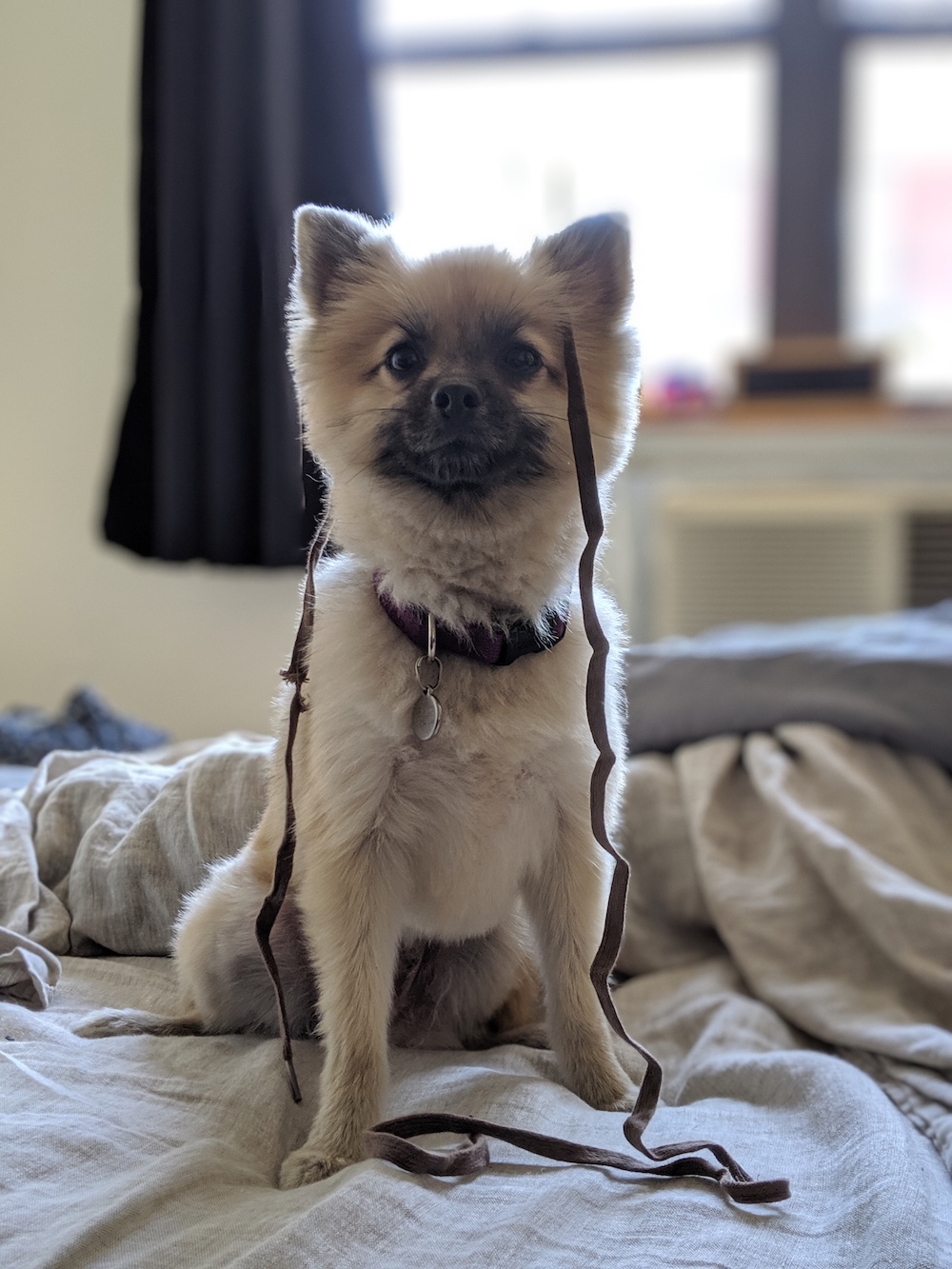
Remus
Pomeranian training
It can be fun to teach a Pom tricks—they’re eager to learn and bond with their people.
Potty training can be a challenge for these dogs, as they may be able to go to the bathroom on part of their bed and move over to sleep elsewhere. And, as smaller dogs, they may not be able to hold their bladders as long. As such, diligent crate training for puppies with many opportunities for bathroom breaks is a good idea.
In general, when it comes to training, you may have to “get inside a Pom’s head” and find a way to convince them that what you want is their idea. “They’re very intelligent dogs,” says Molina. “They’re bred down from sled dogs, so they have that mentality where they think for themselves.” They can be vocal, and alarm, demand, and distress barking can all be issues. But Molina says this isn’t insurmountable as long as you work to understand your pup. “If they’re raised properly and you give them attention and the proper tools and teach them how to be the best version of themselves,” she says, “it doesn’t really become a problem.” Don’t scold your dog—Poms want to please their people and will respond well to positive training techniques.
Poms want to be with their humans—they’re companion dogs whose “job” is mostly to keep you company—and Molina feels that the vast majority of Poms sleep in bed with their people. But, having said that, you won’t be with your Pom constantly. Because all dogs have to spend some time without their people, do what you can to set healthy boundaries and allay separation anxiety. For some specific tips, check out our article on the subject.
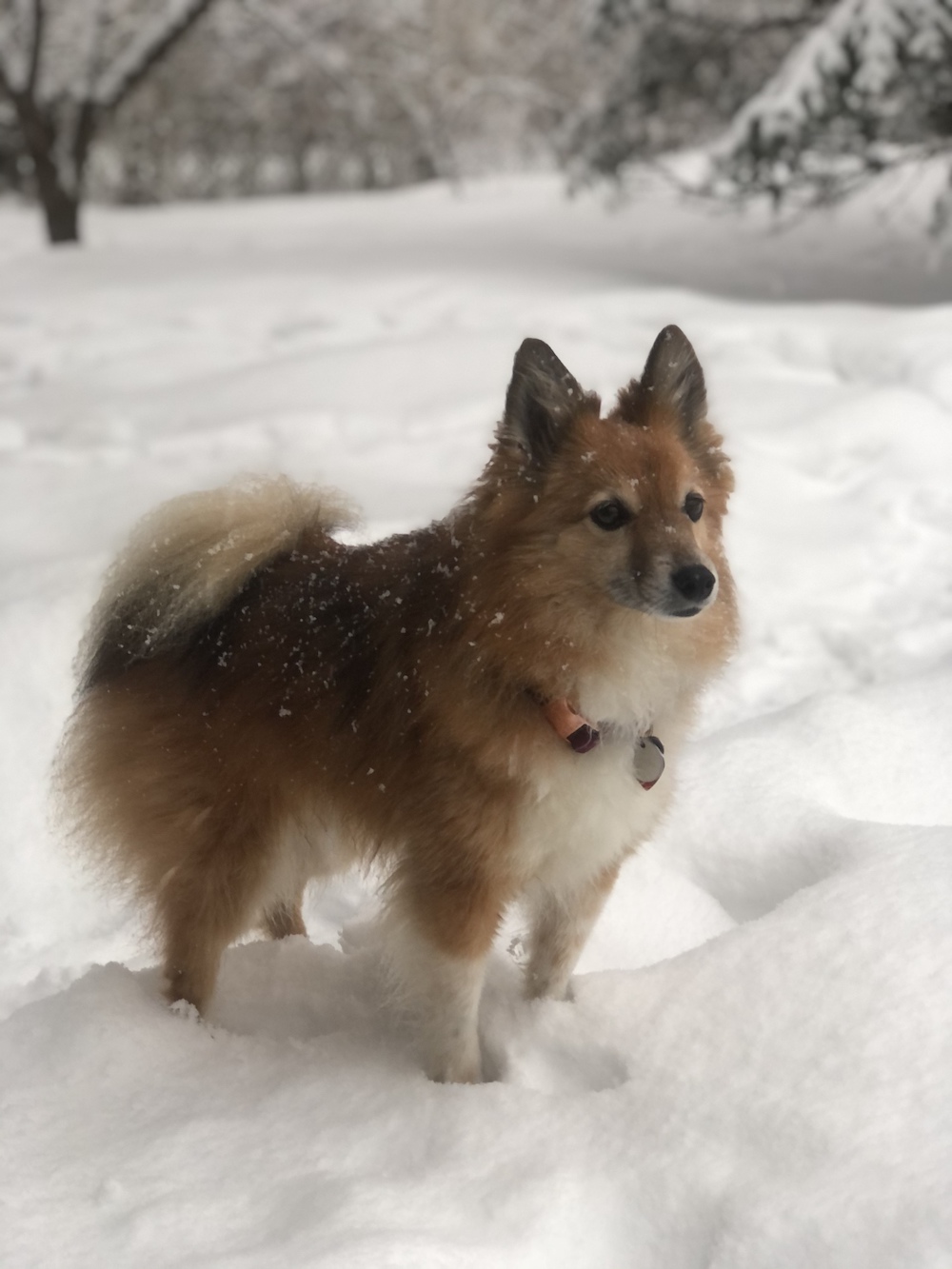
Oliver
Healthy lifestyle for Pomeranians
Exercise
Pomeranians can be good apartment dogs, as you can get them a decent amount of their exercise indoors. Still, they have a lot of energy and will need physical and mental workouts including regular walks—at least a couple a day.
An active Pom may excel at dog sports, either in an organized fashion or informally. See what yours likes, but be careful not to let them jump off of furniture—they could hurt their joints that way. Even if Poms don’t know they’re tiny, they are—so supervise them during play to make sure that larger dogs (or humans) don’t hurt them.
A purebred Pomeranian is a very small dog, which is something you’ll want to keep in mind if you need a dog to be your partner in high-intensity activities like long hikes. Molina remembers one prospective adopter. “She said: ‘I go hiking every day, and I want a dog I can do that with.’ I was like: ‘this dog, if you’re gonna go hiking, it’s gonna need to be in a stroller!’” But Molina’s rescue and others around the country do have larger dogs who are Pom mixes. These dogs may share more in common with larger spitzes who are more used to intense exercise. In this particular case, Molina said, the adopter “decided she wanted one of the bigger Pomeranians. I told her: If you like the look of a Pom and you really like the personality, there are the bigger ones that are more athletic that you can do these things with.”
Pomeranians “are good at agility,” says Molina. “They’re good at scent work. They can do all of that, but it’s not a huge necessity for them. If you don’t do it, it’s not going to destroy their lives. They’re not going to be miserable. Some dogs are miserable if they can’t work.” Whatever your Pom’s routine may be, give them sufficient physical and mental stimulation. Poms are enthusiastic chewers, and may take to food puzzles. They shouldn’t be left at home alone for a long time with nothing to do. If you do leave Pomeranians bored and alone, says Molina, “They’re going to probably bark or destroy something. They’ll shop around the apartment and find something.”
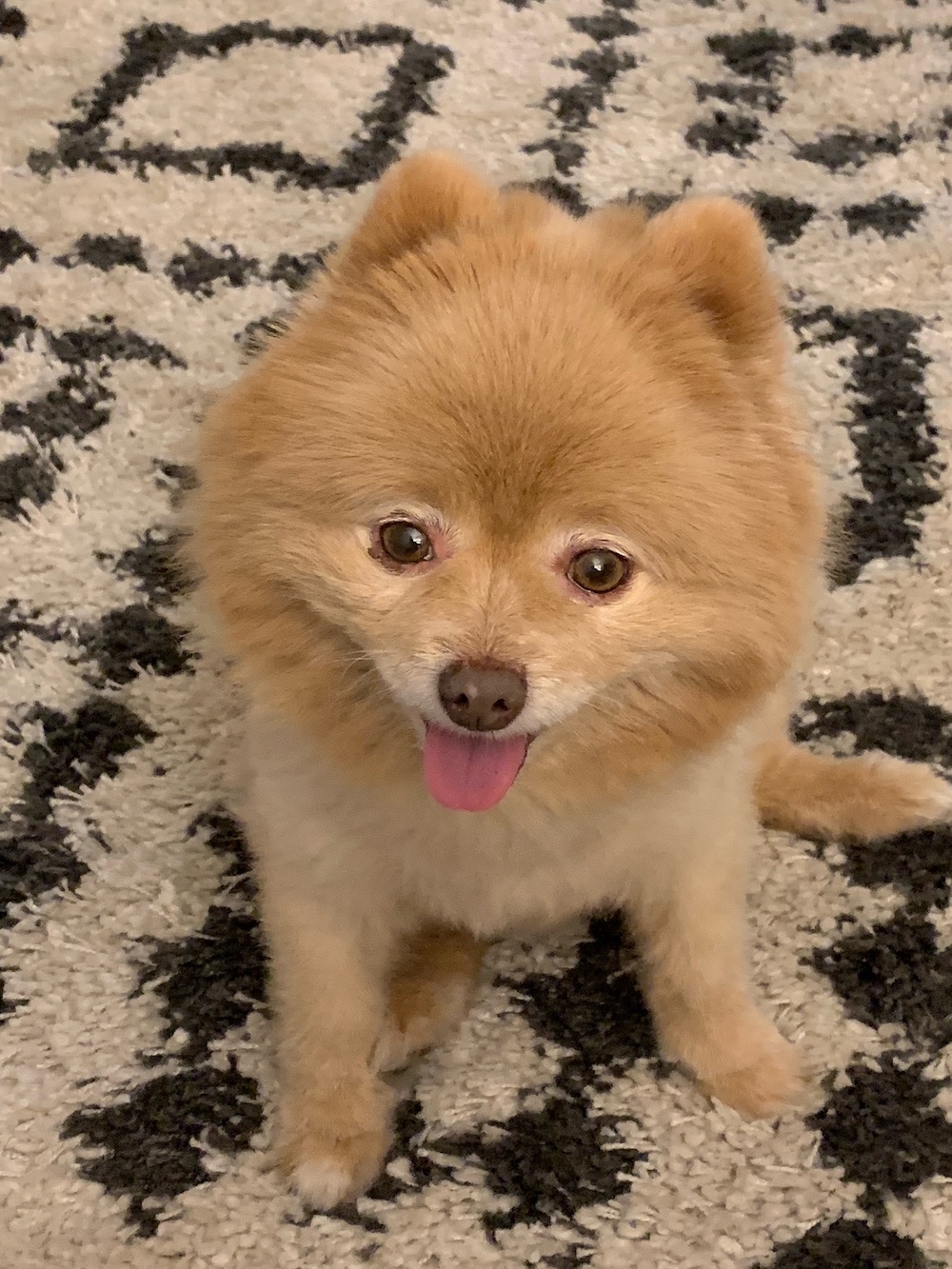
Sophie
Grooming and bathing
Pomeranians’ double coats, whose aesthetically appealing appearance slang aficionados might call “floofy,” is glorious—but it’s also a responsibility, and requires frequent grooming. Here’s a video of a groomer demonstrating proper line brushing (and baby-talking to the Pom she’s brushing). Don’t brush only the top layer of your Pom’s fur.
If you can’t handle your Pom’s brushing, bathing, trimming, ear-cleaning, and nail-trimming needs on your own, there’s no shame in enlisting the help of a professional groomer to keep them looking and feeling their best.
Having said that, there’s a lot to recommend grooming your little buddy yourself. “It can be an experience of bonding and loving for your dog,” Molina says. “You put them on your lap, put a little towel on your lap, lay the dog on its back and just brush its tummy and turn it on its side. And they really love that. The Pomeranians love to be petted and loved and touched.”
Some Pomeranians need their anal glands expressed, lest they become swollen and impacted. If you have any questions about whether this is necessary for your dog—or need tips on how to do it properly—talk to your veterinarian.
Attending to a Pomeranian’s grooming needs is one of the keys to taking care of them properly. “Everything takes work and time,” says Molina. “I kind of joke with people. I say: ‘Maybe a stuffed animal would be better for you if you don’t want to train, clean, or brush the dog.’”

Lucy
Common Pomeranian health problems
Pomeranians are typically long-lived, but Pom owners should be on the lookout for certain conditions that are more common among the breed.
Patellar luxation: This is a condition in which a dog’s kneecap slips out of place. Symptoms to watch for include your Pom picking up one leg and seeming to skip for a few steps, then kicking a leg out to pop the knee back into place. Severe patellar luxation can require surgery, but talk to your veterinarian about options for treating less-advanced cases.
Hypothyroidism: This condition can cause weight gain; lethargy; high cholesterol; thickened facial skin, leading to what some call a “sad” or “tragic” expression; cold intolerance; foot-dragging or lack of coordination; a higher risk of ear and skin infections; and other issues. Hypothyroidism is not curable, but it can be treated via synthetic hormone replacement.
Alopecia X: While Pomeranians have beautiful coats, they are vulnerable to hair loss. Alopecia X, sometimes also known as “black skin disease,” is a condition in which dogs lose some or all of their body hair—usually on the back, tail, thighs, and neck. The exposed skin turns darker. This can be temporary or permanent, and if the hair grows back a Pom may lose it again. If you notice unexpected hair loss, talk to your veterinarian to figure out the cause and what you can do to take care of your pup. The vet may run tests to make sure the hair loss hasn’t been caused by another disease. If your dog does have to go outside without a full coat, protect their skin from the sun with clothing or a dog-safe sunscreen. Like humans, dogs can burn—and if they’re used to having fur that they’ve suddenly lost, their skin will be especially unprepared for direct exposure to the sun’s rays. Your dog can be healthy and happy without treatment as long as you take steps to protect their skin.
Collapsing trachea: If you notice that your dog frequently has a dry cough, and that it gets worse with pressure—for example, from a collar—when they’re excited, or when they’ve just had food or drink, you should talk to their veterinarian. Small-breed dogs like Pomeranians are more likely than others to suffer from tracheal collapse. If the cartilage of their windpipe does become damaged, this could make it hard for them to get enough air—so you should seek medical attention as soon as possible. Medication and surgery can help alleviate the condition, though dogs with tracheal issues may require treatment throughout their lives. Some steps humans can take to help their dogs at home include keeping them at a healthy weight, protecting them from irritants like smoke, and switching from a collar to a harness on walks.
Legg-Calve-Perthes Disease: This degenerative condition impacts the head of the femur—the “ball” of the “ball-and-socket” hip joint. It may be caused by a lack of blood supply to the bone, and because it seems to be hereditary it’s not possible to prevent it. If you notice your dog limping—usually on one leg—or showing signs of pain, contact your veterinarian, who can use a physical exam and imaging tests to make a diagnosis. Depending on the disease’s progression, a vet may advise rest, medication, or surgery and rehabilitation to help improve a dog’s quality of life. Dogs with this condition should not breed, as might pass it on to their puppies.
Dental issues: Pomeranians may be more prone to periodontal disease than most other breeds. Because this often impacts the roots of their teeth, a vet may need to perform X-rays to detect it. Be sure that your vet regularly examines your dog’s teeth during checkups, get professional cleanings if necessary, and institute a daily toothbrushing routine at home.
Heart problems: The American Pomeranian Club recommends cardiac testing for the breed; if you suspect that anything is amiss, don’t hesitate to contact your vet. If you suspect your own dog may have a heart issue, a cardiologist may perform tests like an EKG, X-rays, and blood pressure. Coughing, shortness of breath, and fatigue are among the symptoms that sometimes indicate heart issues—but your dog’s prognosis will be better if you catch any issues before these signs emerge.
Young Poms may suffer from a congenital heart defect called patent ductus arteriosus (PDA). Symptoms of this condition can include shortness of breath and difficulty exercising. If you have any questions about PDA, ask your veterinarian—it is often treatable if caught early, but without treatment it is usually fatal.
Hypoglycemia: The APC says that Pomeranian puppies are also especially prone to low blood sugar, especially if they are very small or active, and recommends consulting with your veterinarian to keep your dog safe.
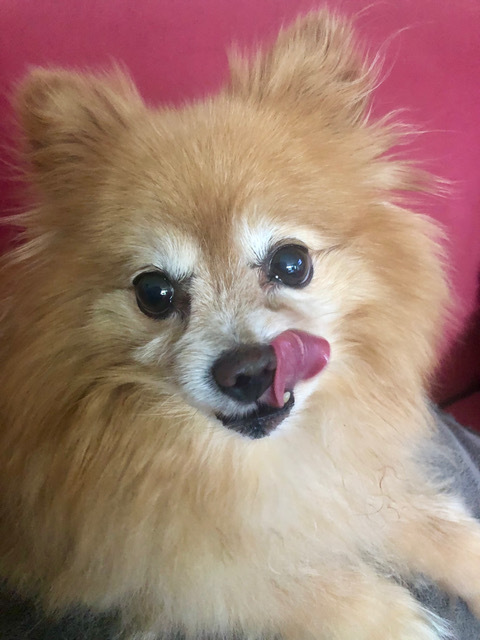
Leelo
Food and nutrition for Pomeranians
As with any breed of dog, it’s important to feed Pomeranians healthy, complete, and balanced food on a regular schedule. Here are some additional considerations for feeding your fluffy pal:
Mind the teeth: Eating for dental health means eating for overall health—a fresh, whole-food diet promotes a healthier immune system, which helps ward off the dental maladies common in this breed. Crunchy kibble is often said to clean teeth, but it does no such thing. In fact, kibble is an ultra-processed food and as such can contain substances that actually fuel inflammation in the body, including in the tissues of the mouth. Most kibble is starchy and full of fillers that break down to sugar, which contributes to plaque and bacteria.
High-quality food for high-quality poops: A diet of fresh, lightly cooked food has been shown to be more digestible than processed kibble, and can promote a healthy gut and good digestion (which also means better, smaller poops).
A healthy diet—alongside ample exercise, training, vet care, and lots of room to race around—is among the keys to giving your Pom a happy life.
Where to get a Pomeranian
If you have decided to get a Pom of your own, a good place to start is a rescue like Southern California Pomeranian Rescue.



